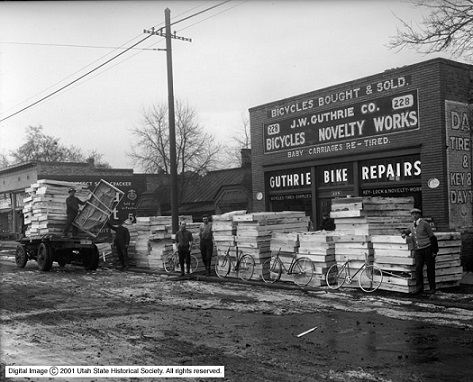Dublin Core
Title
Description
Are you a bicycle commuter? Do you appreciate riding smooth roads on the way to work? Learn how cyclists fought to get Salt Lake City roads paved back in 1901.
Salt Lake City is recognized nationally as a Bicycle Friendly Community, with more than 80 miles of cycle lanes and a bike commuter population that is four times the national average. But Salt Lake was not always so accommodating to bicycle riders.
In 1890, manufacturing advances made bicycles affordable to most Americans, and the freedom offered by this new contraption transformed both American lives and cities. Salt Lake City was caught up in the cycling craze that swept the country, with more than 2500 bicycles filling City streets by 1896. By 1900, half of the City’s 50,000 residents owned bicycles, with nearly every family harboring at least one. The bicycle had become a commuting necessity.
But the growing number of urban cyclists conflicted with pedestrians over the use of sidewalks, where cyclists retreated when the unpaved dirt streets became muddy quagmires in the rain and snow. Laws restricting cyclists from sidewalks did not solve the problem of how to share public thoroughfares. While everyone agreed that the City should pave the streets, no one could agree on how to pay for it. Because of their unusual width, Salt Lake streets were costly to pave. Plus, the streetcar lobby, fearing a decline in rider-ship if roads were paved, convinced the State Legislature to restrict Utah towns from paving more than three miles of road per year. Cyclists themselves were divided, with some arguing that bicycle license fees could pay for better infrastructure, while others argued they already paid taxes to maintain sidewalks and streets, and objected to being double-taxed.
The debate dragged into the 20th Century until frustrated cyclists got organized enough to influence municipal politics. In 1901, a group called the Wheelmen’s Protective Association nominated its own candidates for City offices, and the political challenge was enough to compel some action. Cyclists compromised, agreeing to avoid banned sidewalks and pay a licensing fee, which forced Salt Lake City to finally start constructing paved roads and bike paths.
Creator
Source
Image: JW Guthrie Company Bicycle Shipment. Image shows several piles of crates in front of the J. W. Guthrie Company on 200 South. Muddy roads made commuting on a bicycle dangerous. February 26, 1917. Courtesy of J. Willard Marriott Library.
_______________
See Ted Moore, “Fast Revolutions: Bicycles, Paved Paths, and the Creation of a Middle-Class Salt Lake City, 1890-1903,” Utah Historical Quarterly, Volume 79, Number 3, pp. 264-282; Dave Iltis, “League of American Bicyclists Awards Salt Lake City Silver Status as a Bike Friendly Community,” Cycling Utah: Mountain West Cycling Magazine, May 1, 2010; “Salt Lake City Unveils New Website for Cyclists,” Salt Lake Tribune, May 15, 2012;Salt Lake City Department of Transportation www.slcgov.com/transportation and www.bikeslc.com, accessed 7/4/2012.

